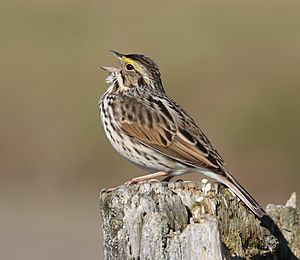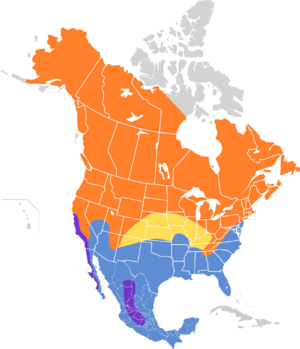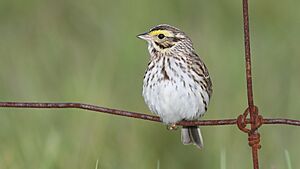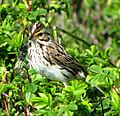Savannah sparrow facts for kids
Quick facts for kids Savannah sparrow |
|
|---|---|
 |
|
| Singing male, probably P. s. labradorius Cap Tourmente National Wildlife Area, Quebec (Canada) |
|
| Conservation status | |
| Scientific classification | |
| Genus: |
Passerculus
|
| Species: |
sandwichensis
|
| Subspecies | |
|
Some 10–20, see article text |
|
 |
|
| Breeding Migration Nonbreeding Year-round | |
| Synonyms | |
|
|
The Savannah sparrow (Passerculus sandwichensis) is a small bird found in North America. It belongs to a group called New World sparrows. This sparrow is the only type of bird in its genus, Passerculus. You can find them in many open grassy areas across North America.
Most Savannah sparrows travel long distances. They spend their summers, or breed, in Canada and the northern United States. When winter comes, they fly south to Mexico and the southern United States. Male and female Savannah sparrows look very similar. However, their appearance can change quite a bit depending on where they live. There are about 17 different types, called subspecies, of Savannah sparrows. These subspecies are grouped, and some were once thought to be completely different species.
The name sandwichensis comes from Sandwich Sound, which is now called Prince William Sound in Alaska. This is where the first Savannah sparrow was found. The common name "Savannah sparrow" comes from Savannah, Georgia. An expert named Alexander Wilson saw the bird there in 1811.
Contents
Discovering the Savannah Sparrow
The Savannah sparrow was first officially described in 1789. A German scientist named Johann Friedrich Gmelin wrote about it. He included it in his updated book, Systema Naturae, which was originally written by Carl Linnaeus. Gmelin first put the bird in the genus Emberiza and gave it the scientific name Emberiza sandwichensis.
Gmelin learned about this bird from earlier descriptions. John Latham had described the "Sandwich bunting" in 1783. Thomas Pennant described the "Unalasha bunting" in 1785. Both Latham and Pennant saw a bird specimen owned by Joseph Banks. This bird was collected in May 1778 in Sandwich Sound, Alaska. It was found during James Cook's third trip around the world. The actual bird specimen is now lost. However, an artist named William Wade Ellis drew a colored picture of it during the trip. This drawing is now kept at the Natural History Museum in London.
Today, the Savannah sparrow is the only species in the genus Passerculus. This genus was created in 1838 by a French scientist named Charles Bonaparte. The name "Savannah sparrow" was first used in 1811 by Alexander Wilson. He saw the bird near Savannah, Georgia, and wrote about it in his book, American Ornithology.
Savannah Sparrow Family Tree
In 2005, scientists studied the DNA of Savannah sparrows. They found that the Ipswich sparrow, which was once considered a separate species, is actually a type of Savannah sparrow. It is a distinct subspecies. Another type, the southwestern large-billed sparrow, was found to be even more different.
Scientists currently recognize 17 subspecies of Savannah sparrows. Many of these are known only from birds seen in winter. The differences between them often change gradually across their habitats. Four other subspecies are no longer widely accepted. The different types of Savannah sparrows are usually divided into several groups:
Savannah Sparrows Proper
All these sparrows migrate, meaning they fly south for winter. Their winter homes often overlap.
- P. s. labradorius: Breeds in Newfoundland, Labrador, and northern Quebec.
- P. s. savanna (eastern Savannah sparrow): Breeds in the northeastern US and nearby Canada.
- P. s. sandwichensis (Aleutian Savannah sparrow): Breeds on the Aleutian Islands and western Alaskan Peninsula.
- P. s. anthinus: Breeds in the rest of Alaska, south and east to central British Columbia. Also found north of the Great Plains to Manitoba.
- P. s. brooksi (dwarf Savannah sparrow): Breeds in southern British Columbia to northern California.
- P. s. alaudinus: Breeds along the coast of northern and central California.
- P. s. nevadensis: Breeds in the northern Great Plains and the Great Basin.
- P. s. brunnescens: Breeds from central Mexico south to Guatemala.
- P. s. wetmorei: A rare subspecies that might breed in the mountains of Guatemala. Only a few specimens have ever been found.
Ipswich Sparrow
These sparrows move around a bit after breeding. They were once thought to be a separate species.
- P. s. princeps: Breeds almost only on Sable Island. This island is southeast of Nova Scotia in the Atlantic Ocean.
The Ipswich sparrow is a bit larger and paler than other eastern Savannah sparrows. The streaks on its chest are thinner and light brown. Some Ipswich sparrows stay on Sable Island all winter. Others fly south along the Atlantic coast. They usually leave later and come back earlier than sparrows on the mainland. Some Ipswich sparrows even breed with P. s. savanna in Nova Scotia. These birds often raise three groups of chicks in a year. The Ipswich sparrow was first seen in winter on the sand dunes near Ipswich, Massachusetts.
Large-billed Sparrows
The large-billed sparrows are sometimes considered a separate species. There are two types that are dark, large, and have strong bills:
- P. s. rostratus: Breeds on the Gulf Coast of northeastern Baja California and northwestern Sonora. They sometimes move around after breeding.
- P. s. atratus: Lives all year on the coast from central Sonora to central Sinaloa.
Belding's Sparrows
Belding's sparrows live all year in the salt marshes along the Pacific coast of California. They are dark and reddish-brown. They have long, but not very thick, bills. This group has also been considered a separate species.
- P. s. beldingi: Lives on the Pacific coast from Morro Bay, California, to El Rosario, Baja California.
- P. s. anulus: Lives around Sebastián Vizcaíno Bay, Baja California.
- P. s. guttatus: Lives around San Ignacio Lagoon.
- P. s. magdalenae: Lives around Magdalena Bay.
San Benito Sparrow
The San Benito sparrow lives on the Islas San Benito islands off Baja California. One bird was seen on Cedros Island in 1906. This type has also been considered a separate species.
- P. s. sanctorum: This subspecies is large-bodied and has a large bill, similar to rostratus. They live in different habitats. Their breeding season does not seem to be the same as Belding's sparrows. Their large bill size is because they have adapted to their environment. Their choice of habitat is simply because there are no other options on their barren island home. It seems they are a fairly new branch from the Belding's sparrows group.
What Savannah Sparrows Look Like
The Savannah sparrow has a back that is streaked brown and looks like a typical Old World sparrow. Its belly is whitish with brown or blackish streaks on its chest and sides. It has whitish stripes on its head and above its eyes. Sometimes these stripes have a bit of yellow, especially near the beak. Its cheeks are brown, and its throat is white. The flight feathers are dark brownish-black with light brown or white edges. Its eyes are dark. The feet and legs are horn-colored, and the lower part of its bill is also horn-colored, while the upper part is dark gray.
This bird can look very different depending on its subspecies. Many of these subspecies have been considered separate species at different times. The main difference between the forms is how dark their feathers are. Birds from Alaska and inland areas are usually the palest. Birds from the southwestern coast are the darkest. There are some exceptions, especially on some islands. Savannah sparrows also vary in size. They can be from 11 to 17 centimeters (4.3 to 6.7 inches) long. Their wingspan can be from 18 to 25 centimeters (7.1 to 9.8 inches). Their body weight ranges from 15 to 29 grams (0.53 to 1.02 ounces). The average weight for the main subspecies is about 20.1 grams (0.71 ounces).
The "Savannah sparrows proper" look very similar to each other. It is often hard to tell where a migrating bird came from. However, the subspecies that stay in one place or only migrate a little can be told apart by their size and color.
Where They Live and What They Like
This passerine bird breeds in Alaska, Canada, and parts of the United States. This includes the northern, central, and Pacific coastal areas. They also breed in Mexico and Guatemala. The sparrows that breed in the Pacific and Mexico stay there all year. Other groups migrate, flying south for winter. They spend winter from the southern United States through Central America and the Caribbean to northern South America. It is very rare to see a Savannah sparrow in western Europe.
Behavior and Diet
These birds look for food on the ground or in low bushes. Especially in winter, you can find them in short grassy areas where animals have grazed. They mostly eat seeds. However, during the breeding season, they also eat insects. During the breeding season, you usually see them in pairs or small family groups. For their winter migration, they gather in larger flocks. Their flight call is a thin seep sound. The Savannah sparrow is generally considered a species of concern by the IUCN. Their song is a mix of chirps and trills.
Gallery









